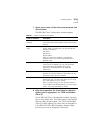
5-2 CHAPTER 5: TROUBLESHOOTING
The items in the following paragraph are performed by
the installation program.
If you are using the NDIS driver (IBMTOKCS.DOS),
edit the PROTOCOL.INI file and see whether you have
specified a particular value for the interrupt level or
memory locations. This would be indicated by the
keywords INTERRUPT=X, MMIO=0xXXXX, or
RAM=0xXXXX. If you are using the ODI driver
(TOKENCS.COM), edit the NET.CFG file and see
whether you have specified a particular value for the
interrupt level or memory locations. This would be
indicated by the keywords INT X, MEM #1 XXXXX, or
MEM #2 XXXXX.
These keywords specify a particular value for these
parameters. If you find one or more of these
keywords, comment them out by placing a semicolon
in front of the keyword. Save the file and reboot your
PC. If all three are commented out or are not in
PROTOCOL.INI or NET.CFG, the driver is in Autoset
mode and lets Card Services determine what values
are used by the driver. If you reboot and still receive
the alternating beep alarm, there is a problem with
Card Services. Check your level of Card Services and
ensure that it is the latest available.
■ If you are using a point enabler
When you use a point enabler, it is essential that the
I/O ports, interrupt, memory areas, and slot number
that are chosen by the enabler agree with what the
LAN device driver is expecting. Problems occur when
the enabler has set up certain resources and the LAN
device driver is expecting others. Typically, the LAN
driver will not initialize. Look at the default values for
the interrupt, whether the 3C389 PC Card is a primary
or secondary 3C389 PC Card (this affects the I/O
ports), and where the MMIO memory and the SRAM
memory are located. Be sure that the enabler settings
and the settings of the LAN driver coincide. By the use
of parameters on the command line of the enabler
and the parameters for the LAN device driver (in
PROTOCOL.INI, NET.CFG, or LSP.INI), you should be
able to configure your 3C389 PC Card to function.


















